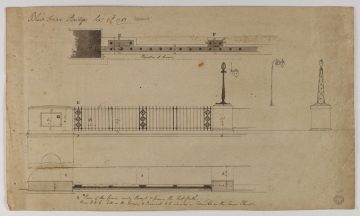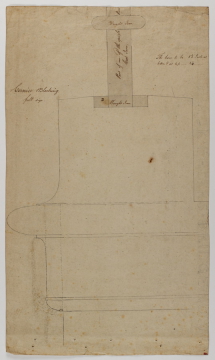
Browse
Reference number
Purpose
Aspect
Scale
Inscribed
Signed and dated
- Sept 2d 1783
Medium and dimensions
Hand
Notes
Soane exhibited a design for 'Blackfriars Bridge, Norwich' at the Royal Academy in 1784. His Plans, elevations and sections of buildings published in 1788 (plate 43) has an 'improved' elevation which shows a more elegantly symmetrical approach than the site permitted. The bridge with its single elliptical arch was built in St George's Street over the River Wensum. Widened (1931) and without its original ironwork, the bridge, which was opened in the spring of 1784, continues in use.
For an unexecuted design for a bridge at Hellesdon near Norwich see Norwich, Norfolk: unexecuted design for a bridge, 1785
See also SM Soane Notebooks 6-10. The first entry for the bridge (7 April 1783) notes that 'General Assembly unanimously agreed to Design & Estimate &c and order the immediate execution. Gave directions to De Carle to pull down the old Bridge'.
Literature
D.Stroud, Sir John Soane, architect, 2nd ed., 1996, pp.119,241
Level
Sir John Soane's collection includes some 30,000 architectural, design and topographical drawings which is a very important resource for scholars worldwide. His was the first architect’s collection to attempt to preserve the best in design for the architectural profession in the future, and it did so by assembling as exemplars surviving drawings by great Renaissance masters and by the leading architects in Britain in the 17th and 18th centuries and his near contemporaries such as Sir William Chambers, Robert Adam and George Dance the Younger. These drawings sit side by side with 9,000 drawings in Soane’s own hand or those of the pupils in his office, covering his early work as a student, his time in Italy and the drawings produced in the course of his architectural practice from 1780 until the 1830s.
Browse (via the vertical menu to the left) and search results for Drawings include a mixture of Concise catalogue records – drawn from an outline list of the collection – and fuller records where drawings have been catalogued in more detail (an ongoing process).




